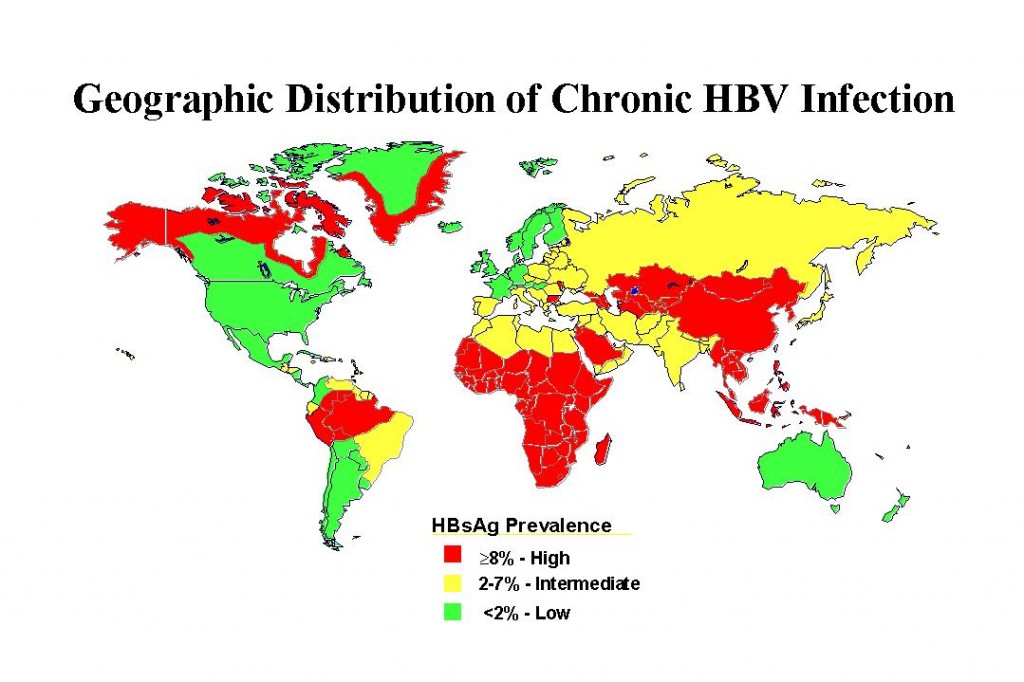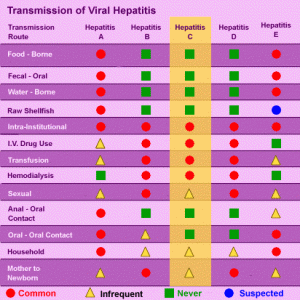There are several other viruses that include “hepatitis” in their proper names. Hepatitis A, which will be discussed in a separate post in this series, is primarily a food-borne infection that is now vaccine preventable and which only rarely causes long term illness or severe liver damage. Hepatitis E, which is uncommon in the United States but which is not uncommon among travelers to the developing world, including Mexico, is very similar to Hepatitis A and is usually food or water borne. Unlike Hepatitis A, Hepatitis E is not vaccine preventable. Hepatitis D is an incomplete virus and cannot cause infection on its own. Hepatitis D can only cause illness when Hepatitis B Virus is also present; therefore, Hepatitis D is vaccine preventable, by extension of the Hepatitis B vaccine, because if Hepatitis B is prevented, Hepatitis D is incapable of causing infection. Hepatitis G Virus, now known primarily as GBV-C, is known to infect humans but it is not believed to cause illness, or at least, not long term illness. There is some evidence that persons infected with both GBV-C and HIV live longer than those without GBV-C co-infection, but this relationship has not been extensively studied and is not understood. GBV-C infection is quite common among those infected with HCV and others with risk factors for HCV infection. Hepatitis F Virus was believed to have been discovered and was thus named in increasing alphabetical order following nomenclature tradition, but its existence has never been confirmed and it is no longer believed to exist. Because the name was used, the next hepatitis virus to be discovered was named Hepatitis G Virus, discussed above. If yet another virus should be discovered that primarily causes liver inflammation, tradition suggests that it would be named Hepatitis H Virus. At this time, HHV does not exist, although a subtype of Hepatitis B Virus is lettered H and may cause confusion among some people. That virus is simply a type of HBV and is not a separate virus in its own right.
The Importance of Environmental Control
Because environmental transmission of HBV and HCV are known, and because environmental transmission of HIV remains at least theoretically possible, it is vital that environments where blood or body fluid contamination are likely to occur, that a disinfectant and cleaning agent be employed that has been tested, documented and EPA certified as effective against all these organisms, and such agents can be surprisingly hard to find. And, some places that might not think that blood and body fluid contamination could be problems actually can be at risk for exactly such contamination. Healthcare facilities of all types are obviously in need of an agent effective against all blood-borne pathogens, but so are facilities such as day care, gyms, and hair and nail salons, and most certainly tattoo and body piercing establishments. And the home environment also presents possibilities for transmission, especially if someone in the home is known to be, or could potentially be, infected with a blood-borne pathogen, for example, the homes of not only patients but also healthcare workers who have a relatively high occupational risk for exposure and infection with a blood-borne pathogen. Practically anyone could benefit from the peace of mind and security of knowing that they routinely clean and disinfect with an agent known to be effective against blood-borne pathogens.


